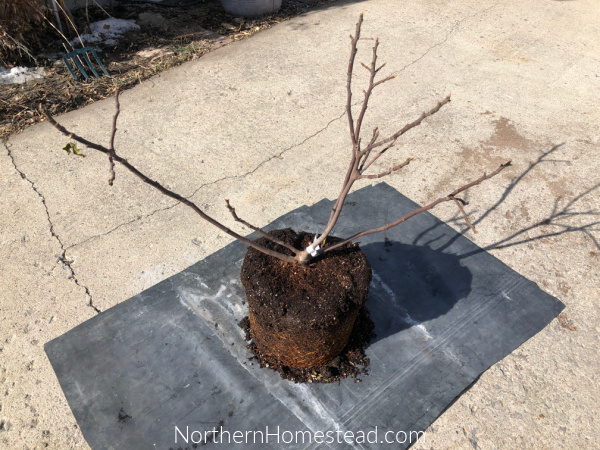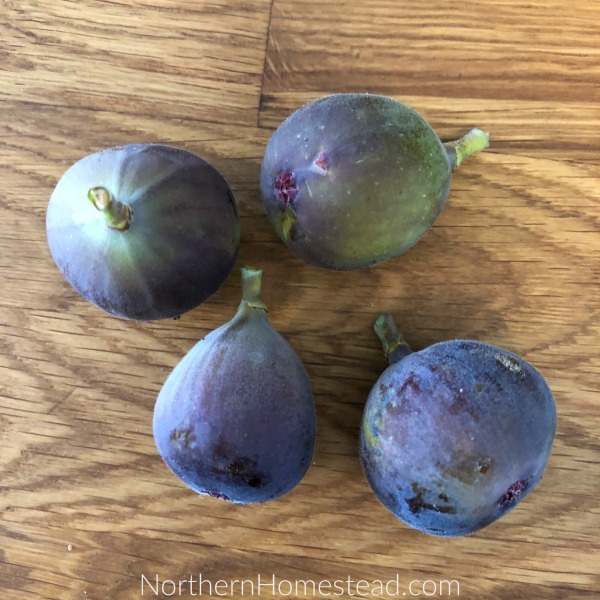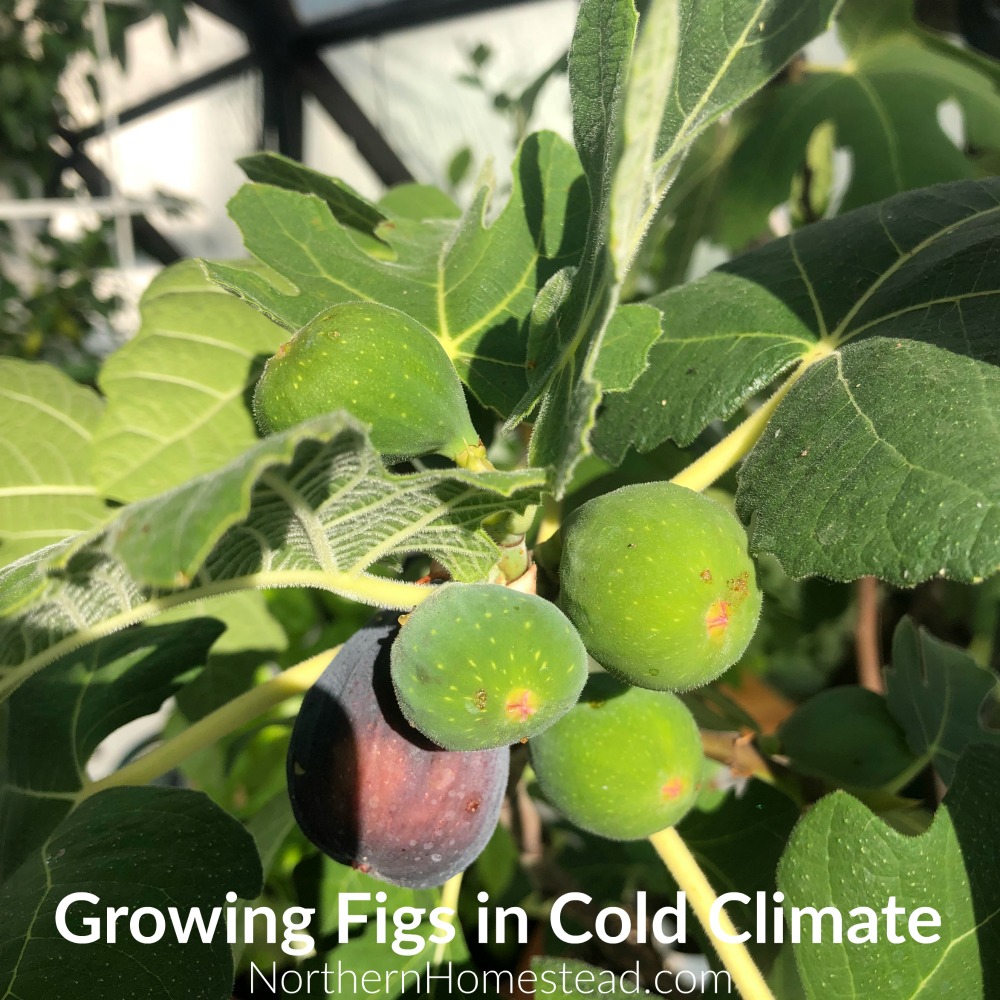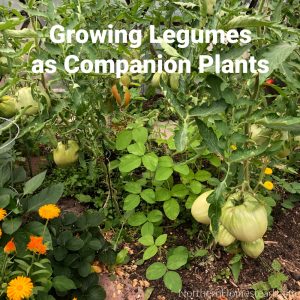
Figs are a sweet treat that is usually grown in a warm climate. As cold climate gardeners, figs usually do not even cross our minds until someone shares on social media something about their figs. Growing figs in a cold climate is possible. We get asked a lot about how we grow figs, so here we share our experiences and as usual, we will add more information as we gain more experience.
4 Things to consider before you order your fig tree
Figs are warm-weather trees but can be small enough to grow in a container. This ability makes it possible to grow and enjoy figs in virtually any climate. Some varieties seem to do better as a potted tree and in a short growing season than others.
Things to consider before getting a fig tree are:
- How much space will that tree need and do we have it available? Depending on the season and conditions, a fig tree in a cold climate needs two to three spots to grow. More on this is below.
- Can we handle a big and often heavy tree? Since the tree cannot be planted out in our cold climate, unless you have a greenhouse sheltered enough, you will have to move and transplant the tree regularly.
- Is there sufficient heat and sunlight in my growing place for figs to ripen? We often just think about the winter, if we bring a tree through the winter it is all good. That is not so. The tree will not produce if the summer is too short and cool. So you will end up with a green tree and no fruit.
- Do we like figs enough to make going through extra hassle worth it? One can grow almost anything imaginable, but to make it worthwhile, we also want to enjoy the fruit of our labor.
Where to order a fig tree for a cold climate

We got our Chicago Fig tree from T&T seeds in Manitoba. For Canadians, this is a great place to get a fig tree. They have even added another fig, the Negronne Fig that is smaller and maybe even better for beginners.
Richters is a great address for an extensive fig collection.
Also, check local greenhouses for fig trees, and ask when is the best time to get one.
I was comfortable buying our tree from a Canadian source and a climate similar to ours, knowing that if it grows there, it should be fine here. Stores are not always concerned about local conditions, so research to understand if the fig variety you’re getting will grow in your conditions.
Transplanting the Fig Tree

Fig trees usually arrive in a small pot and need to be transplanted right away. T&T seeds suggested transplanting the tree directly into a 10-inch pot to start.
Figs like to feel secure in their containers and will grow well in tight containers. The container itself will also help to shrink the overall size of the tree. A 10 to 15-gallon container could be this plant’s final home.

We transplanted our tree again in February, before bringing it into the sunroom. We choose a slightly bigger pot.
Transplanting is best done when the tree is dormant. It can be done in the fall or early spring. After our first fall transplant, we switched to spring.

The tree needs a new pot when the roots fill out the old pot. In our experience, it is about every second year. Since we want to keep the tree small and manageable, we have stopped potting the tree up and are keeping it in an about 7-gallon pot.
When the tree grows out of that pot, we simply prune the roots back and fill the pot with new soil.
For soil Mel’s Mix from the All New Square Foot Gardening book is great. Mixing together equal parts of compost, vermiculite, and peat moss. A good potting soil works too.
Dividing and propagating the fig tree
Fig trees are vigorous growers. If you want to keep them small it is easy to multiply one tree into two and more.

Here we documented in pictures the first division of our initial tree. It had grown very wide, so we wondered if we could make two out of one.

First, we loosened all the roots to be able to separate them. Then we literally divided them apart. With that a third little guy came apart too, so we planted all three. Note how the smaller tree actually has more roots.

All of them grew nicely. But the one with more roots really took off.


It also had lots and lots of figs in the same summer. So do not hesitate to transplant, root prune, and even divide fig trees. New growth means more fruit.
Figs can also be easily propagated from cuttings. When trimming the tree, put the sticks in water and see if they grow roots.
Pruning a fig tree
When we first started we knew nothing about pruning, so as usual, we looked for information online on how to do it. This video here has lots of information on pruning and some of the things we already discussed.
Important to know is that fig trees will produce the main crop of fruit on new growth. For us in a cold climate where we have to move the trees around a lot, it really is a great way to prune the trees quite severely and still get a great crop the same year. See the dividing example above.
The tree will continue to grow year after year and respond to trimming. These can grow to about 12 ft tall and about 10 ft wide. Depending on how you trim them you can shape them to grow as a bush or as a tree.
Fertilizing and watering the fig tree

The potted fig trees need to be fed at least once a month and more when they are fruiting. Seaweed and 10-52-17 are excellent food recommended by T&T seeds. Gaia natural fertilizer is another option.
Depending on what soil we used to plant them into, meaning if it had compost in it or not, I also like to use organic all-purpose spikes. They slowly release some fertilizer between watering with fertilizer.
For watering keep their soil moist, but not wet. Figs are tropical plants and do not like wet feet. Use warm water at room temperature, again remember they like it warm.
The tree might not need watering during the dormant season. Just make sure it does not dry out completely.
Location for the fig tree

We got our tree in the spring of 2018 and after transplanting it, we kept it in our geodesic dome greenhouse. To our surprise, it developed some fruit and the fruit ripened already in our first summer.
We could see though, that a late spring start does not give the tree enough time to develop and ripen a lot of fruit.

We left the tree in the greenhouse until late October, so that the tree could go dormant the natural way to lose all the leaves and get ready for winter. Our Chicago fig tree is hardy to zone 5, meaning it can handle some frost and should have a resting wintertime. Not all varieties are the same, make sure to check your variety on how much frost if at all it can handle.

For the winter, before it got freezing cold in the greenhouse, we moved the tree into our unheated garage. Again, we are in zone 3, so the unheated garage does get frost, but not more than a zone 5 garden would.
I don’t recall watering the tree during the winter, and our garage only has west-facing windows, meaning the tree did not get any sunlight. I don’t think it matters since the tree was dormant at this stage.
In February, we brought the tree into our growing room at the back of our garage, gave it a new pot, and watered it well. The tree reacted with buds and new growth.

We have kept that practice ever since, except our garage is no longer not heated, but we keep the temperature very low (around 8C). We try to bring the tree in late February to early March, depending on the weather, into the growing sunroom to give it an early start.
The early start is important so you get some of the new growth fruit. That fruit is more delicious than the first quick figs, and also there is more of it. If you don’t have a grow room, a sunny window will do.
During the summer we keep the trees in the geodesic dome greenhouse. They seem to love the extra heat, and give us lots of fruit.
Give them the warmest spot you have. If they are outside, find a sheltered location from the wind.
Figs do not need pollinators. Technically if there is enough light, they can be kept indoors all year round.
Harvesting figs

Fig tree produces two crops during the summer. One early that ripens mid-summer and one that ripens in late fall.

Figs are ripe when they change color and are soft. They form a drop shape as they ripen more. At that stage they are sweet and delicious, a real treat.
We had to learn that the window when the figs are perfectly ripe is relatively small. If not picked, the tree drops the fruit and it rots. We lost a few due to not knowing this.

Adding a fig tree to our garden has been a real joy. We would recommend it to anyone who is open to some growing adventure.
If you grow a fig tree, please share your best tips with us.
We invite you to subscribe to Northern Homestead and follow us on Instagram, Facebook, or Pinterest for the latest updates.












Excellent advice! My husband is Italian, from the south, and he tells me often about the wonderful fruit that they had. We had considered an indoor fig tree but they do take over…didn’t now they can be from zone 5.
This is a reasonable way to grow a fig tree for fun and we do have a south facing living room which we could set it up in for the early spring and to extend the season a bit in the fall before it goes to bed in the fall.
Thanks!
You are welcome. This will not be the big a juice figs your husband might remember from Italian, but nevertheless, they are figs. So happy growing!
Hi fig lovers, Yes, they can be grown in cold climates. The Chicago fig is one of the hardiest. For best results in a cold climate, plant the fig tree in the ground on the South side of the house , and preferably 6 or 7 feet in front of a dark colored brick wall, and at least one month before cool weather sets in . (actually , cold winds are likely to kill the tree, so the windbreak and heat retained by bricks act to raise the micro-climate around the tree to create hardiness to 1 lower zone ) Also mulch heavily around the tree. One nice thing about this fig variety is even if the top of tree is killed by frost , it will regrow from the roots and produce fruit in the same year. If you have a short summer and not enough time to allow figs to fully ripen on tree, just pick figs when they turn brown and move them to a warm place and they will ripen just fine !
Thank you for sharing your experience. In our Zone 3 I tried to plant a fig seedling in a greenhouse and it did not survive. You must be in a much higher zone than us.
Good Morning Anna, I love this post your doing! I do some landscape work for a customer and they grow a huge fig tree on their side yard. I harvested a “sprout” that was growing off an exposed root and potted it up. It survived and turned into 3 branches. I finally picked a spot to plant it and put it in ground September of 2017. The following year something attacked the bud on the top of one branch and that was a blessing in disguise! It caused the formation of necessary side branches. My plan is to esplaire it. I’ve seen some that are grown this way (also in greenhouses) and it’s a great way to grow them when you have limited room. Now I have to remove the other two branches. Those have grown quite tall and once I get them removed I’ll pot them up and experiment with them. The Fig tree owner has no idea what type of fig he’s got since it was planted by a previous owner but I’m thinking it’s a Desert King, tasteless but very sweet. My intention is to make Fig Syrup from them and have my own sweetener. Cheers!
Pruning is a whole new thing that I have yet to learn. It is interesting that you plant the branches you cut off. Do you root them in water first? Thank you for sharing.
Since I last responded I chickened out cutting the 2 excess branches off! I dug down to the base and they are all connected at one spot. I didn’t want to make such an exposed wound on it. Well, game change. What I will do is go ahead and install my heavy-duty T-posts and anchor a cut-down cattle panel to it, keeping the cattle panel 3 to 4 feet off the ground so I can clean under it, to spread- train the branches on it. I’ll keep the “well branched one” at center to do what I intended to do and the other 2 I’ll train to go in opposite directions of each other and just see what happens. Mine looks very much like your potted fig. I’ve seen propagation done with “Cutting Globes” and this is some information I gleaned in a conversation: (Quote) Figs root so easily here, I usually just stick my cuttings into the ground, if the winter looks like it’s going to be harsh, I bundle some cuttings together and roll them up in several layers of damp, but not wet newspaper. Then insert in plastic bag with end open for ventilation . May take several weeks, but then little white roots appear all along the cuttings, then pot up. Hoping you put some kind of mulch around your figs , as many roots run laterally for many feet in all directions. I’ve had some as far as 20ft! (Invading other beds) They freeze easily. (End Quote) My neighbors fig tree roots are a bit surface exposed but it’s growing area is very limited. It’s in need of a good pruning by an expert. He’s allowed unknowledgeable people to prune it and it’s been severely damaged but they have a way of coming back!